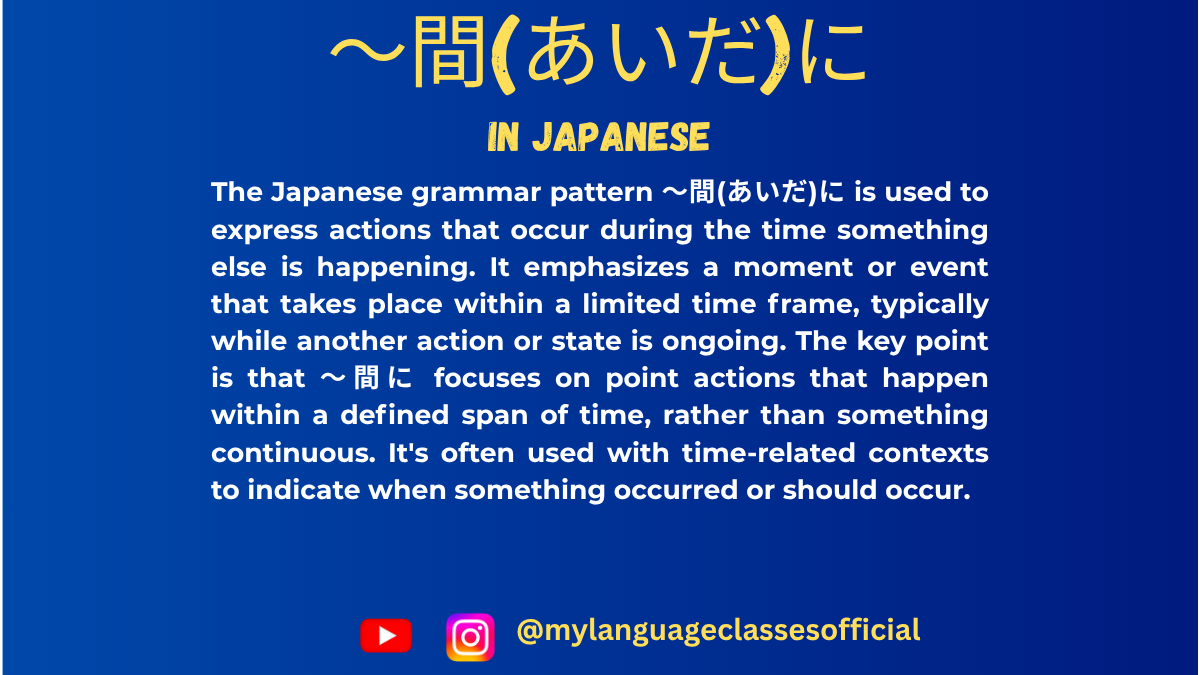Your cart is currently empty!
Tag: language
-

Use of Infinitive After Prepositions in Spanish
In Spanish, when a verb follows a preposition, it must always be in its infinitive form. Unlike English, where the gerund (-ing form) is often used after prepositions, Spanish strictly requires the infinitive. Understanding this grammatical rule is essential for forming correct sentences and sounding natural in Spanish.
This blog post will cover the different situations in which the infinitive is used after prepositions, common expressions with their meanings and examples, and essential points to keep in mind while using them.
Situations Where the Infinitive is Used After Prepositions
- Purpose or Goal (para + infinitive)
- Used to indicate the purpose or objective of an action.
- Example: Estudio para aprender. (I study to learn.)
- Means or Manner (con + infinitive)
- Expresses the way in which something is done.
- Example: Mejorarás con practicar. (You will improve by practicing.)
- Cause or Reason (por + infinitive)
- Indicates the reason for an action.
- Example: Me castigaron por llegar tarde. (They punished me for arriving late.)
- Condition (de + infinitive)
- Expresses conditions in certain phrases.
- Example: De saberlo, te lo habría dicho. (Had I known, I would have told you.)
- After Prepositions of Time (antes de/después de + infinitive)
- Used when referring to actions occurring before or after another action.
- Example: Voy a ducharme después de correr. (I am going to shower after running.)
- Prepositions Indicating a Point of Reference (sin, hasta, en, etc.)
- Used in fixed expressions and idiomatic phrases.
- Example: No puedes salir sin avisar. (You can’t leave without letting us know.)
Common Expressions with Infinitives After Prepositions
Expression Meaning Example 1 Example 2 Para estudiar To study Voy a la biblioteca para estudiar. Uso aplicaciones para estudiar español. Por llegar tarde For arriving late Me regañaron por llegar tarde. Perdí el tren por salir tarde. Con practicar By practicing Mejoras con practicar cada día. Con practicar, hablas mejor. Antes de dormir Before sleeping Leo antes de dormir. Me lavo la cara antes de dormir. Después de comer After eating Me cepillo los dientes después de comer. Llamó después de almorzar. Sin avisar Without warning No puedes irte sin avisar. Entró sin avisar. Hasta terminar Until finishing No salgo hasta terminar la tarea. No puedo descansar hasta terminar. De saberlo Had I known De saberlo, no lo habría hecho. De saberlo antes, te habría avisado. En aprender In learning Invierto tiempo en aprender español. Me esfuerzo en aprender bien. A pesar de fallar Despite failing Sigo intentándolo a pesar de fallar. Aprobó a pesar de fallar el primer intento.
More Example Sentences
- Fui al mercado para comprar frutas.
- No puedes entrar sin pagar la entrada.
- Me llamó después de haber terminado el trabajo.
- Logró su meta con dedicarse al estudio.
- Antes de salir, revisa tu mochila.
- Me fui temprano por evitar el tráfico.
- No puedes dormir sin apagar la luz.
- No podré jugar hasta mejorar mi salud.
- De haber sabido la verdad, habría reaccionado diferente.
- A pesar de tener miedo, enfrentó la situación.
Fill in the Blanks
- Voy al gimnasio ________ estar en forma. (para)
- Me castigaron ________ decir una mentira. (por)
- No puedes viajar ________ tu pasaporte. (sin)
- Voy a descansar ________ trabajar todo el día. (después de)
- No saldré ________ terminar el proyecto. (hasta)
- Aprendí español ________ estudiar mucho. (con)
- De ________ que vendrías, habría preparado algo especial. (saber)
- Siempre leo un libro ________ dormir. (antes de)
- Se esforzó mucho ________ ganar el premio. (para)
- Consiguió su objetivo ________ muchos intentos fallidos. (a pesar de)
Answers
- para
- por
- sin
- después de
- hasta
- con
- saber
- antes de
- para
- a pesar de
Things to Keep in Mind
- The verb after the preposition always remains in its infinitive form.
- Prepositions like para, por, sin, antes de, and después de commonly appear before infinitives.
- In cases where an article (el, la, los, las) is used, ensure agreement in gender and number.
- Some phrases change meaning slightly depending on the preposition used (e.g., por estudiar vs. para estudiar).
Conclusion
Using the infinitive after prepositions is a fundamental rule in Spanish. Unlike English, which often uses gerunds, Spanish requires the verb to stay in its base form. Mastering this concept will improve fluency and accuracy in constructing sentences. Practice with the expressions provided, and soon, this rule will become second nature in your Spanish conversations!
If you enjoyed this lesson, be sure to check out more posts like this on my blog at My Language Classes. Don’t forget to subscribe my YouTube channel and follow me on Instagram for the latest language learning tips and lessons. Leave a comment below to share your thoughts, or ask any questions you have.
Happy learning! 😊
- Purpose or Goal (para + infinitive)
-

Prepositions of Place in English
Prepositions of place are essential in English as they help indicate the location of people, objects, or actions. Understanding them correctly enhances fluency and accuracy in spoken and written English. This article will provide a detailed explanation, a categorized list, examples, exercises, and essential things to remember while using prepositions of place.
What is a Preposition of Place?
A preposition of place is a word used to show the location or position of an object concerning another object. These prepositions answer the question “Where?” and are essential for clear communication.
List of Prepositions of Place and Their Usage
Below is a list of commonly used prepositions of place along with their meanings and example sentences.
Preposition Usage Example 1 Example 2 In Inside a space, area, or container The books are in the bag. She is in the room. On On the surface of something The book is on the table. There is a painting on the wall. At A specific point or location She is at the bus stop. We met at the restaurant. Under Below something The cat is under the table. He hid under the bed. Over Above something without touching The lamp is over the table. The bridge is over the river. Above Higher than something The clock is above the door. Planes fly above the clouds. Below Lower than something His shoes are below the bed. The valley is below the mountain. Between In the middle of two things The park is between the school and the mall. She sat between her friends. Next to Beside something The school is next to the hospital. She is sitting next to her brother. Behind At the back of something The car is behind the building. There is a garden behind the house. In front of Before something The teacher is in front of the class. There is a park in front of my house. Inside Within an enclosed space The keys are inside the drawer. She stayed inside the house. Outside Opposite of inside The kids are playing outside the house. There is a cat outside the shop. Near Close to something There is a bank near my house. She lives near the station. Far from Distant from something His school is far from his home. The hotel is far from the airport.
More Example Sentences:
- There is a mirror on the wall.
- The plane is flying above the clouds.
- She is waiting at the entrance.
- The ball is under the chair.
- The bakery is next to the supermarket.
- He kept his phone inside his pocket.
- The children are playing outside the house.
- The library is between the coffee shop and the bank.
- The painting is hanging over the sofa.
- There is a tree behind the house.
Fill in the Blanks:
- The cat is ___ the table.
- The park is ___ the school and the library.
- She is waiting ___ the bus stop.
- The ball rolled ___ the couch.
- The students are sitting ___ the teacher.
- The books are ___ the bag.
- The hotel is ___ the beach.
- The keys are ___ the drawer.
- He is standing ___ the door.
- The stars are shining ___ the sky.
Answers:
- under
- between
- at
- under
- in front of
- in
- near
- inside
- behind
- above
Things to Keep in Mind:
- Articles: Use definite and indefinite articles appropriately (e.g., “in a house” vs. “in the house”).
- Gender & Number: Prepositions of place do not change based on gender but may be influenced by singular/plural usage (e.g., “between two buildings”).
- Fixed Expressions: Some prepositions are part of set phrases, such as “at home,” “on the street,” or “in bed.”
- Context Matters: Some prepositions can change meaning based on the context (e.g., “on the bus” vs. “in the car”).
- Prepositions vs. Adverbs: Some words can function as both prepositions and adverbs. For example, “inside” can be a preposition in “inside the house” but an adverb in “Come inside!”
Conclusion
Prepositions of place are fundamental in English grammar and crucial for describing locations accurately. By understanding their usage and practicing them through exercises, you can significantly improve your English fluency. Keep practicing with real-life situations, and soon, using prepositions of place will become second nature!
If you enjoyed this lesson, be sure to check out more posts like this on my blog at My Language Classes. Don’t forget to subscribe my YouTube channel and follow me on Instagram for the latest language learning tips and lessons. Leave a comment below to share your thoughts, or ask any questions you have about nouns.
Happy learning! 😊
-
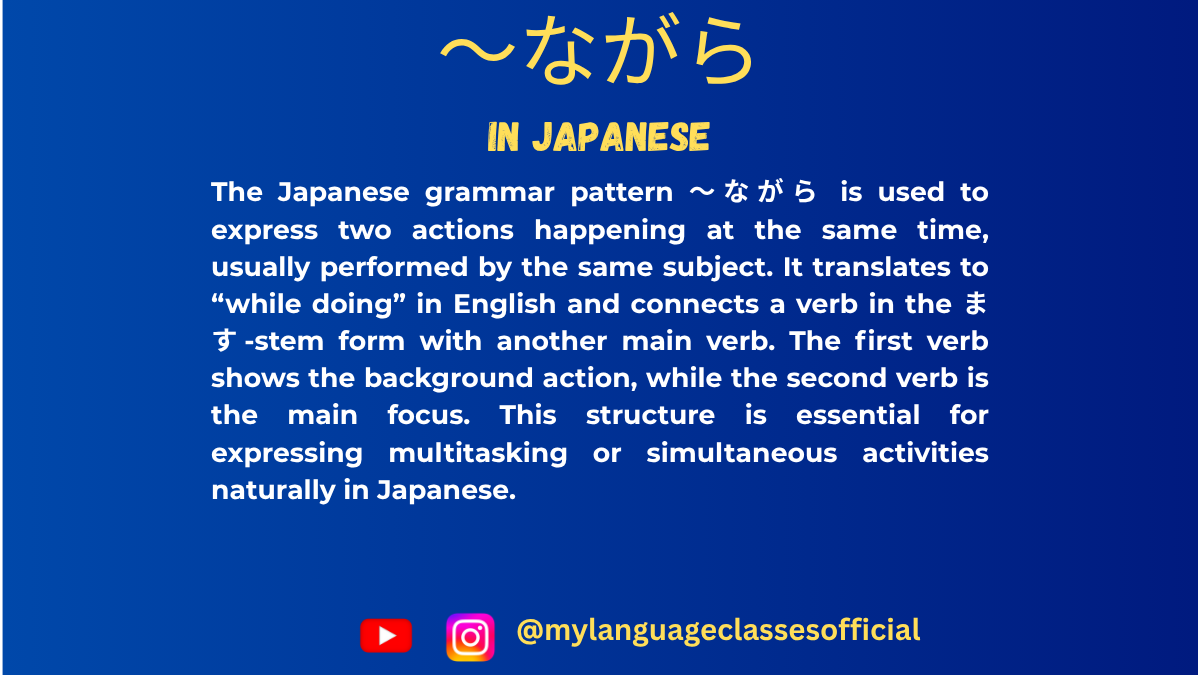
Using 〜ながら Form in Japanese | My Language Classes
〜ながら Form in Japanese
The 〜ながら (nagara) form is an essential Japanese grammar structure used to describe two actions happening simultaneously. It is widely used in both casual and formal conversations to indicate multitasking or actions occurring at the same time.
In this blog, we will explore the formation of 〜ながら for all three verb groups, its various usages, and a comprehensive list of verbs with example sentences. Additionally, we will provide a section with more example sentences, fill-in-the-blank exercises, key points to remember, and a conclusion.
Formation of 〜ながら for Different Verb Groups
Japanese verbs are categorized into three groups: Group 1 (Godan verbs), Group 2 (Ichidan verbs), and Group 3 (Irregular verbs). Each group follows a specific rule for forming 〜ながら.
1. Group 1 (Godan Verbs)
For Godan verbs, take the ます-stem of the verb and add ながら.
- Example Formation
- 話す (hanasu – to speak) → 話しながら (hanashinagara – while speaking)
- 書く (kaku – to write) → 書きながら (kakinagara – while writing)
2. Group 2 (Ichidan Verbs)
For Ichidan verbs, remove る from the dictionary form and add ながら.
- Example Formation
- 食べる (taberu – to eat) → 食べながら (tabenagara – while eating)
- 見る (miru – to see) → 見ながら (minagara – while watching)
3. Group 3 (Irregular Verbs)
There are only two irregular verbs in Japanese: する and くる.
- Example Formation
- する (suru – to do) → しながら (shiinagara – while doing)
- くる (kuru – to come) → きながら (kinagara – while coming)
Situations Where 〜ながら Form is Used
- Describing Two Simultaneous Actions
- 音楽を聞きながら勉強する (Ongaku o kikinagara benkyou suru) – Study while listening to music.
- Multitasking in Daily Life
- テレビを見ながらご飯を食べる (Terebi o minagara gohan o taberu) – Eat while watching TV.
- Speaking While Performing Another Action
- 笑いながら話す (Warainagara hanasu) – Talk while laughing.
- Contrasting Two Simultaneous Actions
- 悲しみながら笑う (Kanashiminagara warau) – Laugh while feeling sad.
- Working or Performing a Task While Doing Something Else
- 仕事をしながらコーヒーを飲む (Shigoto o shinagara koohii o nomu) – Drink coffee while working.
Verb List with 〜ながら Form and Example Sentences
Verb (Dictionary Form) 〜ながら Form Example Sentence (Japanese) Romaji English Translation 話す (hanasu) 話しながら (hanashinagara) 彼は笑いながら話しました。 Kare wa warainagara hanashimashita. He spoke while laughing. 書く (kaku) 書きながら (kakinagara) 先生は黒板に書きながら説明した。 Sensei wa kokuban ni kakinagara setsumei shita. The teacher explained while writing on the board. 読む (yomu) 読みながら (yominagara) 彼女は本を読みながら寝てしまった。 Kanojo wa hon o yominagara nete shimatta. She fell asleep while reading a book. 見る (miru) 見ながら (minagara) 子供たちはアニメを見ながら笑った。 Kodomotachi wa anime o minagara waratta. The children laughed while watching anime. 歩く (aruku) 歩きながら (arukinagara) 彼は音楽を聞きながら歩いた。 Kare wa ongaku o kikinagara aruita. He walked while listening to music. 食べる (taberu) 食べながら (tabenagara) 彼女はテレビを見ながら食べる。 Kanojo wa terebi o minagara taberu. She eats while watching TV. 泳ぐ (oyogu) 泳ぎながら (oyoginagara) 彼は海で泳ぎながら歌った。 Kare wa umi de oyoginagara utatta. He sang while swimming in the sea.
More Example Sentences
- 音楽を聞きながら勉強する。
Ongaku o kikinagara benkyou suru.
Study while listening to music. - コーヒーを飲みながらニュースを見る。
Koohii o nominagara nyuusu o miru.
Watch the news while drinking coffee. - 料理をしながらラジオを聞く。
Ryouri o shinagara rajio o kiku.
Listen to the radio while cooking. - 車を運転しながら歌う。
Kuruma o unten shinagara utau.
Sing while driving. - 宿題をしながら電話をする。
Shukudai o shinagara denwa o suru.
Talk on the phone while doing homework.
Fill in the Blanks Questions
- 本を______ながら、リラックスします。(読む)
- 音楽を______ながら、運転する。(聞く)
- 仕事を______ながら、テレビを見る。(する)
- ご飯を______ながら、友達と話す。(食べる)
- 日本語を______ながら、メモを取る。(勉強する)
Answers
- 読みながら (yominagara)
- 聞きながら (kikinagara)
- しながら (shiinagara)
- 食べながら (tabenagara)
- 勉強しながら (benkyou shinagara)
Things to Keep in Mind
- The subject of both actions must be the same.
- The ながら clause comes before the main action.
- ながら is used only for actions, not states.
Conclusion
The 〜ながら form is an important grammar structure in Japanese that allows smooth expression of simultaneous actions. By practicing with various verbs and sentences, you will become more fluent in using it naturally in conversations.
Keep practicing and incorporating 〜ながら into your daily Japanese studies!
If you enjoyed this lesson, be sure to check out more posts like this on my blog at My Language Classes. Don’t forget to subscribe my YouTube channel and follow me on Instagram for the latest language learning tips and lessons. Leave a comment below to share your thoughts, or ask any questions you have about nouns.
Happy learning! 😊
- Example Formation
-
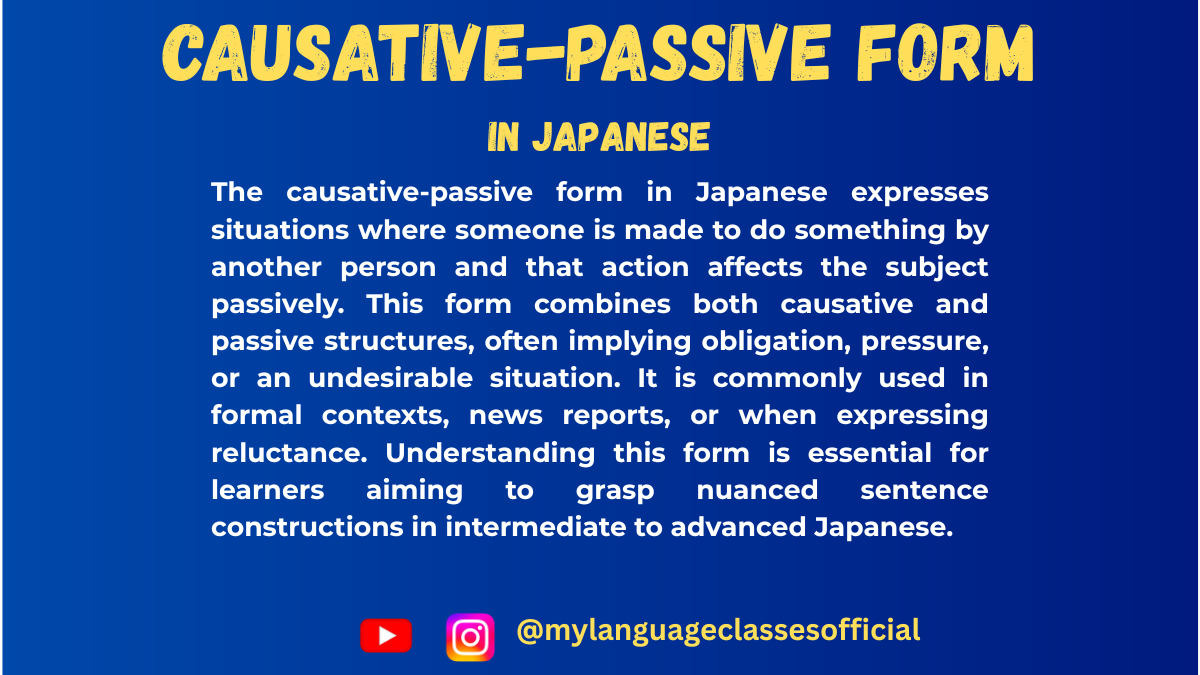
Causative-Passive Form of verbs in Japanese | My Language Classes
Causative-Passive Form in Japanese
The causative-passive form (使役受身, shieki ukemi) in Japanese is an important grammatical structure that conveys a sense of being forced or made to do something against one’s will. This form is frequently used in formal speech, written language, and storytelling.
Formation of Causative-Passive Verbs
To form the causative-passive form, we first conjugate the verb into its causative form and then change it into its passive form.
Group 1 (Ichidan) Verbs
- Convert the verb to its causative form:
- Drop る and add させる (for positive causative)
- Convert the causative form to its passive form:
- Drop る and add られる
Example:
- 食べる (たべる, taberu) → 食べさせる (たべさせる, tabesaseru) → 食べさせられる (たべさせられる, tabesaserareru)
Group 2 (Godan) Verbs
- Convert the verb to its causative form:
- Change the u sound to a and add せる
- Convert the causative form to its passive form:
- Change せる to せられる or される
Example:
- 書く (かく, kaku) → 書かせる (かかせる, kakaseru) → 書かせられる (かかせられる, kakaserareru)
Group 3 (Irregular) Verbs
- する → させる → させられる
- くる → こさせる → こさせられる
Usage of the Causative-Passive Form
The causative-passive form is primarily used in the following situations:
- Expressing Forced Action
- “I was made to do something.”
- Indicating an Unwanted Situation
- “I ended up in an unfavorable situation.”
- In Formal Writing & Passive Expressions
- Commonly used in news articles, literature, and business settings.
- Indirect Authority or Control
- Used when talking about school, work, or hierarchical relationships.
- Apologizing or Explaining a Difficult Situation
- “I was put in a tough spot.”
List of Causative-Passive Verbs with Examples
Verb Causative-Passive Form Example Sentence 1 Romaji English Meaning Example Sentence 2 Romaji English Meaning 書く (kaku) 書かせられる (kakaserareru) 先生に作文を書かせられた。 Sensei ni sakubun o kakaserareta. I was forced to write an essay by the teacher. 上司にレポートを書かせられた。 Joushi ni repooto o kakaserareta. I was made to write a report by my boss. 食べる (taberu) 食べさせられる (tabesaserareru) 嫌いな野菜を食べさせられた。 Kirai na yasai o tabesaserareta. I was made to eat vegetables I dislike. 子供のころ、嫌いな魚を食べさせられた。 Kodomo no koro, kirai na sakana o tabesaserareta. When I was a child, I was made to eat fish I disliked. 話す (hanasu) 話させられる (hanasaserareru) 上司に長いスピーチを話させられた。 Joushi ni nagai supiichi o hanasaserareta. I was made to give a long speech by my boss. 友達に嘘を話させられた。 Tomodachi ni uso o hanasaserareta. I was forced to tell a lie by my friend. 読む (yomu) 読まさせられる (yomasaserareru) 先生に長い本を読まさせられた。 Sensei ni nagai hon o yomasaserareta. I was forced to read a long book by the teacher. 上司に新聞を読まさせられた。 Joushi ni shinbun o yomasaserareta. I was made to read the newspaper by my boss. 行く (iku) 行かさせられる (ikasaserareru) 先生に学校に行かさせられた。 Sensei ni gakkou ni ikasaserareta. I was made to go to school by the teacher. 父に病院に行かさせられた。 Chichi ni byouin ni ikasaserareta. I was forced to go to the hospital by my father. More Example Sentences
- 先生に漢字を100回書かせられた。
Sensei ni kanji o hyakkai kakaserareta.
I was forced to write kanji 100 times by the teacher. - 母に部屋を掃除させられた。
Haha ni heya o souji saserareta.
I was made to clean my room by my mother. - 部長に遅くまで働かさせられた。 Buchou ni osoku made hatarakasaserareta. I was made to work late by my manager.
- 先生に難しい問題を解かさせられた。 Sensei ni muzukashii mondai o tokasaserareta. I was forced to solve a difficult problem by the teacher.
- 親に謝らさせられた。 Oya ni ayamarasaserareta. I was made to apologize by my parents.
Conclusion
The causative-passive form is a useful grammatical structure for expressing situations where someone is forced to act against their will. While it is more common in written and formal contexts, mastering this form will greatly enhance your Japanese comprehension and expression skills. Keep practicing with different verbs and real-life situations to fully grasp the nuances of this construction!
If you enjoyed this lesson, be sure to check out more posts like this on my blog at My Language Classes. Don’t forget to subscribe my YouTube channel and follow me on Instagram for the latest language learning tips and lessons. Leave a comment below to share your thoughts, or ask any questions you have about nouns.
Happy learning! 😊
- Convert the verb to its causative form:
-
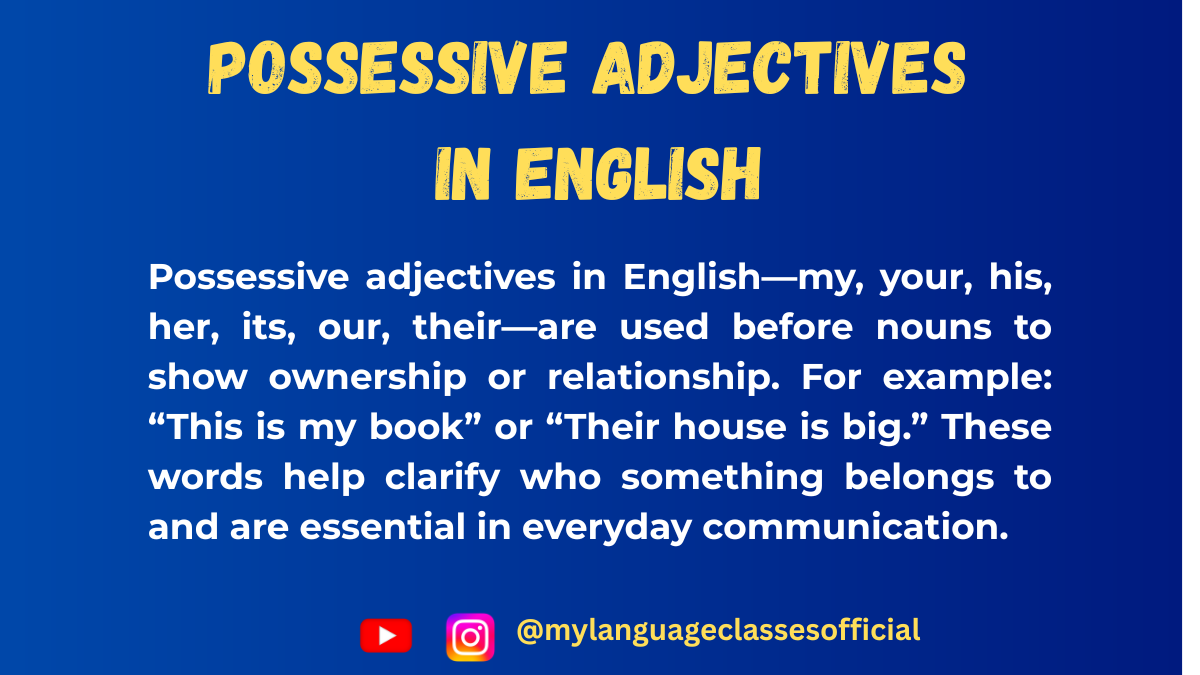
Possessive Adjectives in English
Possessive adjectives are essential in English grammar as they help us indicate ownership or possession. They modify nouns to show who something belongs to and are widely used in everyday communication. In this blog post, we will explore possessive adjectives, their usage, examples, and exercises to help you master them.
What Are Possessive Adjectives?
Possessive adjectives are words that show ownership or belonging. They always come before a noun and modify it to indicate possession. The most common possessive adjectives in English are:
- my
- your
- his
- her
- its
- our
- their
These adjectives replace the need for a noun to show possession explicitly.
Usage of Possessive Adjectives
Possessive adjectives are used in various situations:
- Indicating Ownership – Used to show that something belongs to someone.
Example: This is my book. - Talking About Relationships – Used to describe family members, friends, or connections.
Example: His brother is a doctor. - Describing Body Parts – Used instead of definite articles (e.g., the).
Example: She injured her leg. - Referring to Pets and Objects – Used to show ownership of pets or things.
Example: The dog is wagging its tail. - Indicating Group Ownership – Used for plural subjects.
Example: This is our house. - Addressing Someone Formally and Informally – “Your” can be used in both formal and informal contexts.
Example: Your car is parked outside. - Expressing Feelings or Thoughts – Used to describe personal emotions, beliefs, or opinions.
Example: My opinion is different from yours. - Talking About Time and Events – Used when referring to specific times or occasions.
Example: We enjoyed our holiday. - Indicating Professional Roles or Responsibilities – Used for job positions or tasks.
Example: Her manager is very supportive. - Possession in Abstract Concepts – Used for things like names, ideas, or dreams.
Example: His idea was brilliant.
List of Possessive Adjectives with Example Sentences
Possessive Adjective Beginner Level Example Intermediate Level Example My This is my pen. My thoughts are clear now. Your Is this your book? I respect your decision. His His bike is red. I don’t understand his logic. Her Her dress is beautiful. Her dedication to work is impressive. Its The dog wagged its tail. The company changed its policy. Our Our school is big. We must protect our environment. Their Their house is near the park. Their success is well-deserved. More Example Sentences
- She forgot her keys at home.
- This is my favorite song.
- I love your cooking.
- He took his jacket and left.
- The cat licked its paws.
- We had a great time at our wedding.
- They visited their grandparents last summer.
- Please submit your assignments on time.
- He is proud of his achievements.
- The dog followed its owner.
Fill in the Blanks
- Is this ___ book? (your/my)
- He forgot ___ phone at home. (his/its)
- We love spending time with ___ family. (our/their)
- She borrowed ___ pen to write a note. (his/her)
- The cat licked ___ fur after the bath. (its/her)
- They celebrated ___ anniversary last night. (their/our)
- I don’t understand ___ reasoning. (his/your)
- We went to ___ favorite restaurant. (my/our)
- The teacher praised ___ students. (her/his)
- You should respect ___ elders. (their/your)
Answers
- your
- his
- our
- her
- its
- their
- his
- our
- her
- your
Things to Keep in Mind
- Possessive adjectives must be followed by a noun. (e.g., My car is new. NOT My is new.)
- “Its” is not the same as “it’s.” (“Its” shows possession, while “it’s” is a contraction of “it is.”)
- Possessive adjectives do not change based on gender except “his” and “her.”
- Unlike possessive pronouns, possessive adjectives always require a noun. (e.g., This is my book. vs. This book is mine.)
- Possessive adjectives agree with the possessor, not the thing possessed. (e.g., His sister (not Her sister) when referring to a boy’s sister.)
Conclusion
Possessive adjectives play a crucial role in English grammar by indicating ownership and relationships. They are commonly used in everyday communication and are easy to learn with practice. By understanding their usage and applying them in sentences, you can improve your English fluency significantly. Keep practicing with the examples and exercises provided, and soon, possessive adjectives will become second nature to you!
If you enjoyed this lesson, be sure to check out more posts like this on my blog at My Language Classes. Don’t forget to subscribe my YouTube channel and follow me on Instagram for the latest language learning tips and lessons. Leave a comment below to share your thoughts, or ask any questions you have about nouns.
Happy learning! 😊
-
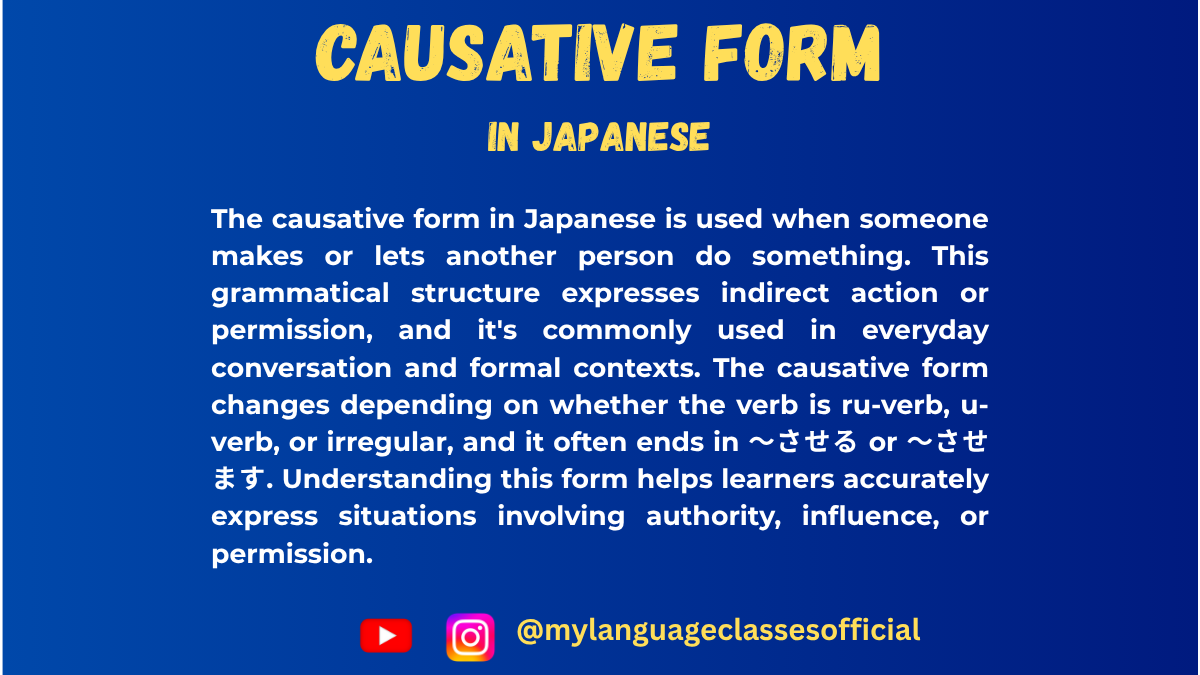
Causative Form of Verbs in Japanese | My Language Classes
Understanding Causative Form in Japanese
The causative form in Japanese is used to express situations where someone makes or allows another person to do something. This grammatical structure is essential for both beginners and intermediate learners as it plays a vital role in daily conversations and formal settings.
Formation of the Causative Form
The causative form in Japanese follows a specific conjugation pattern based on the verb group.
Group 1 (Ichidan Verbs – る-verbs)
- Drop る and add させる
- Example: 食べる → 食べさせる (taberu → tabesaseru) – “to make/let someone eat”
Group 2 (Godan Verbs – う-verbs)
- Change the final う sound to あ and add せる
- Example: 書く → 書かせる (kaku → kakaseru) – “to make/let someone write”
Irregular Verbs
- する → させる
- くる → こさせる
Usage of Causative Form
1. Making Someone Do Something
When the subject forces someone to do something.
- 先生は生徒に本を読ませた。
- Sensei wa seito ni hon o yomaseta.
- “The teacher made the student read the book.”
2. Allowing Someone to Do Something
When the subject permits another person to do something.
- 母は子供にアイスクリームを食べさせた。
- Haha wa kodomo ni aisukurīmu o tabesaseta.
- “The mother let the child eat ice cream.”
3. When Used with Intransitive Verbs
It means “to let someone” do something.
- 友達は私を早く帰らせた。
- Tomodachi wa watashi o hayaku kaeraseta.
- “My friend let me go home early.”
4. Causative-Passive Form (When Someone Is Made to Do Something Unwillingly)
- 先生に宿題をたくさんやらせられた。
- Sensei ni shukudai o takusan yaraserareta.
- “I was made to do a lot of homework by the teacher.”
Situations Where Causative Form Is Used
- Forcing someone to do something
- Giving permission to do something
- Describing workplace instructions
- Formal requests in a business setting
- Parenting and teaching situations
- Expressing feelings of obligation
- Telling someone to act on your behalf
Beginner and Intermediate Level Verbs with Causative Form and Example Sentences
Verb (Dictionary Form) Causative Form Example Sentence 1 Romaji English Example Sentence 2 Romaji English 食べる (taberu) 食べさせる (tabesaseru) 母は私に野菜を食べさせた。 Haha wa watashi ni yasai o tabesaseta. “My mother made me eat vegetables.” 先生は生徒に昼ご飯を食べさせた。 Sensei wa seito ni hirugohan o tabesaseta. “The teacher let the students eat lunch.” 行く (iku) 行かせる (ikaseru) 父は私を学校に行かせた。 Chichi wa watashi o gakkō ni ikaseta. “My father made me go to school.” 先生は生徒を旅行に行かせた。 Sensei wa seito o ryokō ni ikaseta. “The teacher let the students go on a trip.” 書く (kaku) 書かせる (kakaseru) 先生は生徒に作文を書かせた。 Sensei wa seito ni sakubun o kakaseta. “The teacher made the student write an essay.” 彼は弟に手紙を書かせた。 Kare wa otōto ni tegami o kakaseta. “He made his younger brother write a letter.”
More Example Sentences
- 先生は生徒に宿題をやらせた。
- 友達は私にその映画を見させた。
- 母は私に皿を洗わせた。
- 父は私にピアノを弾かせた。
- 会社は社員に報告書を書かせた。
- 医者は患者に薬を飲ませた。
- 先生は学生を立たせた。
- 兄は弟に犬を散歩させた。
- 友達は私に試験の問題を解かせた。
- 父は私に手伝いをさせた。
Fill in the Blanks
- 先生は生徒に本を ___ 。
- 母は子供に野菜を ___ 。
- 友達は私を早く ___ 。
- 父は私に宿題を ___ 。
- 医者は患者に薬を ___ 。
- 先生は生徒に黒板に字を ___ 。
- 社長は部下にレポートを ___ 。
- 兄は弟にピアノを ___ 。
- 友達は私に試験の答えを ___ 。
- 先生は学生を立たせた。
Answers
- 読ませた
- 食べさせた
- 帰らせた
- やらせた
- 飲ませた
- 書かせた
- 書かせた
- 弾かせた
- 解かせた
- 立たせた
Things to Keep in Mind
- The causative form can indicate both “making someone do” and “letting someone do” an action.
- The causative-passive form (e.g., やらせられる) is often used when someone is forced to do something against their will.
- The particle に is used to indicate the person being caused to act.
- Some sentences may sound unnatural if used without context, so always consider the situation.
Conclusion
The causative form in Japanese is essential for expressing permission, coercion, and obligation. Mastering it will help you create more nuanced sentences in conversations and formal settings. Keep practicing with different verbs and contexts, and soon, using the causative form will become second nature!
If you enjoyed this lesson, be sure to check out more posts like this on my blog at My Language Classes. Don’t forget to subscribe my YouTube channel and follow me on Instagram for the latest language learning tips and lessons. Leave a comment below to share your thoughts, or ask any questions you have about nouns.
Happy learning! 😊
- Drop る and add させる
-
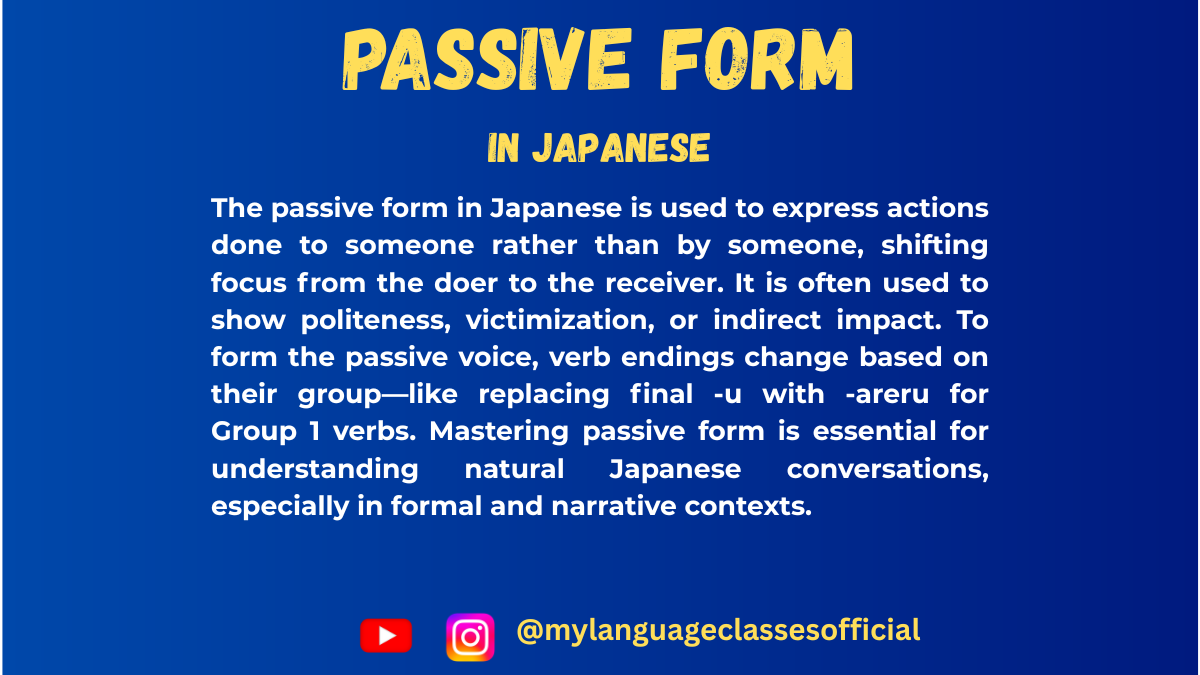
Passive Form of Verbs in Japanese | My Language Classes
Understanding Passive Form in Japanese
The passive form (受身形, うけみけい) in Japanese is used in various situations, primarily to describe actions where the subject is affected by someone else’s actions. Unlike in English, where the passive voice is often avoided, Japanese frequently uses it in daily conversations and formal writing. In this blog post, we will thoroughly explore the formation and usage of passive verbs in different contexts.
Usage of Passive Form in Japanese
The passive form is used in the following situations:
- When someone is negatively affected by an action (被害受身 – ひがいうけみ)
- Japanese: 私は弟にケーキを食べられました。
- Romaji: Watashi wa otōto ni kēki o taberaremashita.
- Meaning: I had my cake eaten by my younger brother.
- When describing an event from the perspective of the affected person
- Japanese: 私は先生にほめられました。
- Romaji: Watashi wa sensei ni homeraremashita.
- Meaning: I was praised by my teacher.
- When discussing historical or public events
- Japanese: このお寺は100年前に建てられました。
- Romaji: Kono otera wa hyaku nen mae ni tateraremashita.
- Meaning: This temple was built 100 years ago.
- When avoiding mentioning the doer explicitly (formal, impersonal expressions)
- Japanese: 日本ではお米が多く食べられています。
- Romaji: Nihon de wa okome ga ōku taberareteimasu.
- Meaning: Rice is widely eaten in Japan.
- When talking about natural phenomena
- Japanese: その山は雪で覆われています。
- Romaji: Sono yama wa yuki de ōwareteimasu.
- Meaning: That mountain is covered with snow.
- In literary or poetic expressions
- Japanese: 彼女の歌は世界中で聞かれています。
- Romaji: Kanojo no uta wa sekaijū de kikareteimasu.
- Meaning: Her songs are heard all over the world.
Formation of Passive Verbs
Japanese verbs are categorized into three groups. The passive form is formed differently for each group.
Group 1 (Ichidan verbs / 一段動詞)
Formation: Drop the final る and add られる
Verb Potential Form Passive Form Example Sentence (Japanese) Romaji Meaning 食べる (たべる) 食べられる 食べられる 私は友達にお菓子を食べられた。 Watashi wa tomodachi ni okashi o taberareta. I had my sweets eaten by a friend. 見る (みる) 見られる 見られる 私の秘密はみんなに見られた。 Watashi no himitsu wa minna ni mirareta. My secret was seen by everyone. 教える (おしえる) 教えられる 教えられる 日本語は先生に教えられた。 Nihongo wa sensei ni oshierareta. Japanese was taught by the teacher. Group 2 (Godan verbs / 五段動詞)
Formation: Change the final u sound to a sound and add れる
Verb Potential Form Passive Form Example Sentence (Japanese) Romaji Meaning 書く (かく) 書ける 書かれる 私の名前が黒板に書かれた。 Watashi no namae ga kokuban ni kakareta. My name was written on the blackboard. 読む (よむ) 読める 読まれる この本は多くの人に読まれた。 Kono hon wa ōku no hito ni yomareta. This book was read by many people. 言う (いう) 言える 言われる 先生に「すごい」と言われた。 Sensei ni “sugoi” to iwareta. I was told “amazing” by the teacher. Group 3 (Irregular verbs / 不規則動詞)
Verb Potential Form Passive Form Example Sentence (Japanese) Romaji Meaning する できる される 彼の仕事は上司に評価された。 Kare no shigoto wa jōshi ni hyōka sareta. His work was evaluated by the boss. 来る (くる) 来られる 来られる 私の家に友達が来られた。 Watashi no ie ni tomodachi ga korareta. A friend came to my house.
More Example Sentences
- 彼は友達にからかわれた。 (Kare wa tomodachi ni karakawareta.) – He was teased by his friends.
- 雨が降って、試合が中止された。 (Ame ga futte, shiai ga chūshi sareta.) – The match was canceled due to rain.
- 私の自転車が盗まれた。 (Watashi no jitensha ga nusumareta.) – My bicycle was stolen.
- その映画は世界中で見られている。 (Sono eiga wa sekaijū de mirareteiru.) – The movie is being watched worldwide.
- 彼は先生に叱られた。 (Kare wa sensei ni shikarareta.) – He was scolded by the teacher.
- この本は多くの人に読まれた。 (Kono hon wa ōku no hito ni yomareta.) – This book was read by many people.
- 先生に質問が聞かれた。 (Sensei ni shitsumon ga kikareta.) – A question was asked by the teacher.
- 日本では魚がよく食べられる。 (Nihon de wa sakana ga yoku taberareru.) – Fish is often eaten in Japan.
- その話は新聞に書かれていた。 (Sono hanashi wa shinbun ni kakareteita.) – That story was written in the newspaper.
- 彼の名前は歴史に残されている。 (Kare no namae wa rekishi ni nokosareteiru.) – His name is left in history.
Fill in the Blanks Exercise:
- 私の名前が黒板に____。
- 先生にほめ____。
- 私は友達にお弁当を____。
- その建物は100年前に____。
- その映画はたくさんの人に____。
- 宿題が____。
- 彼は友達に____。
- その話は新聞に____。
- 日本では魚がよく____。
- 彼の仕事は上司に____。
Answers:
- 書かれた 2. られた 3. 食べられた 4. 建てられた 5. 見られた 6. された 7. からかわれた 8. 書かれた 9. 食べられる 10. 評価された
Things to Keep in Mind
- Passive verbs often imply an indirect effect on the subject.
- Passive form is commonly used in formal writing and polite speech.
- Certain verbs are more frequently used in passive form, such as 言う (to say), 書く (to write), and する (to do).
- When the subject is negatively affected, the nuance of 被害受身 (negative passive) comes into play.
- Passive sentences often omit the doer (agent) for a softer, indirect tone.
Conclusion
Mastering the passive form of verbs in Japanese is crucial for fluency and understanding natural speech patterns. It is widely used in both formal and informal contexts. By practicing passive verb conjugations and understanding their nuanced usage, learners can improve their comprehension and communication skills in Japanese effectively. Keep practicing and using these forms in daily conversation to become more proficient!
If you enjoyed this lesson, be sure to check out more posts like this on my blog at My Language Classes. Don’t forget to subscribe my YouTube channel and follow me on Instagram for the latest language learning tips and lessons. Leave a comment below to share your thoughts, or ask any questions you have about nouns.
Happy learning! 😊
- When someone is negatively affected by an action (被害受身 – ひがいうけみ)

